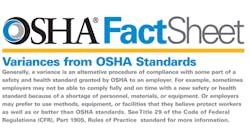Employers seeking a variance – a regulatory action that permits an employer to deviate from the requirements of an OSHA standard under specified conditions – now have access to improved information providing insight into the background of variances, variance qualification guidelines, the application process and why certain applications are denied.
A variance does not provide an outright exemption from a standard, except in cases involving national defense. According to OSHA, employers can request a variance for many reasons, including not being able to fully comply on time with a new safety or health standard because of a shortage of personnel, materials, or equipment.
Employers also may prefer to use methods, equipment, or facilities that they believe protect workers as well as, or better than, OSHA standards. The agency may grant a variance to employerswhen they can prove that their proposed methods, conditions, practices, operations, or processes provide workplaces that are at least as safe and healthful as the workplaces provided by the OSHA standards from which they are seeking the variance.
Previously, OSHA only provided information about approved variance cases. Now, the agency offers information about denied applications to illustrate which requirements businesses failed to meet during the variance application process.
OSHA’s variance Web page also provides background on variance rules and additional application instructions. View the variance site or download OSHA’s variance fact sheet (PDF) to learn more about the different types of variances and how to apply.

